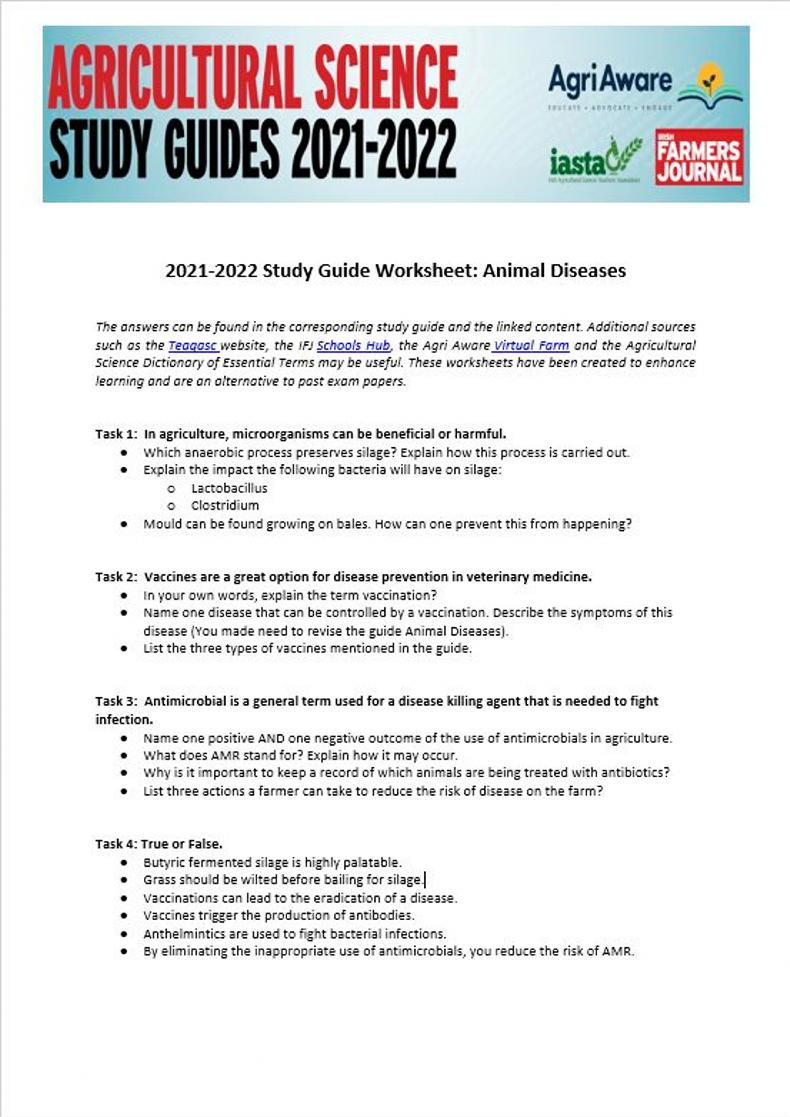Each week, a brand-new original student worksheet will be available to complement each one of the study guides, which can be used by students in class or at home.
The original worksheets will include various tasks from comprehension exercises, dictionary work, multiple choice questions and more.
The worksheets have been designed to enhance learning of the new Leaving Certificate material and as alternatives to exam questions.
The worksheets can be used as a tool to assess self-learning or, alternatively, classroom assessment.
The answers can be found in the corresponding study guide and the linked content. Additional sources such as the Irish Farmers Journal website, Teagasc website (http://www.teagasc.ie/), and the Agri Aware Virtual Farm may be useful.
Task 1: In agriculture, microorganisms can be beneficial or harmful.
Which anaerobic process preserves silage? Explain how this process is carried out.Explain the impact the following bacteria will have on silage: - Lactobacillus.
- Clostridium.
Mould can be found growing on bales. How can one prevent this from happening?Task 2: Vaccines are a great option for disease prevention in veterinary medicine.
In your own words, explain the term vaccination?Name one disease that can be controlled by a vaccination. Describe the symptoms of this disease (you made need to revise the guide animal diseases). List the three types of vaccines mentioned in the guide. Task 3: Antimicrobial is a general term used for a disease-killing agent that is needed to fight infection.
Name one positive AND one negative outcome of the use of antimicrobials in agriculture.What does AMR stand for? Explain how it may occur.Why is it important to keep a record of which animals are being treated with antibiotics?List three actions a farmer can take to reduce the risk of disease on the farm?Task 4: True or false.
Butyric fermented silage is highly palatable. Grass should be wilted before bailing for silage.Vaccinations can lead to the eradication of a disease. Vaccines trigger the production of antibodies. Anthelmintics are used to fight bacterial infections. By eliminating the inappropriate use of antimicrobials, you reduce the risk of AMR. 
Each week, a brand-new original student worksheet will be available to complement each one of the study guides, which can be used by students in class or at home.
The original worksheets will include various tasks from comprehension exercises, dictionary work, multiple choice questions and more.
The worksheets have been designed to enhance learning of the new Leaving Certificate material and as alternatives to exam questions.
The worksheets can be used as a tool to assess self-learning or, alternatively, classroom assessment.
The answers can be found in the corresponding study guide and the linked content. Additional sources such as the Irish Farmers Journal website, Teagasc website (http://www.teagasc.ie/), and the Agri Aware Virtual Farm may be useful.
Task 1: In agriculture, microorganisms can be beneficial or harmful.
Which anaerobic process preserves silage? Explain how this process is carried out.Explain the impact the following bacteria will have on silage: - Lactobacillus.
- Clostridium.
Mould can be found growing on bales. How can one prevent this from happening?Task 2: Vaccines are a great option for disease prevention in veterinary medicine.
In your own words, explain the term vaccination?Name one disease that can be controlled by a vaccination. Describe the symptoms of this disease (you made need to revise the guide animal diseases). List the three types of vaccines mentioned in the guide. Task 3: Antimicrobial is a general term used for a disease-killing agent that is needed to fight infection.
Name one positive AND one negative outcome of the use of antimicrobials in agriculture.What does AMR stand for? Explain how it may occur.Why is it important to keep a record of which animals are being treated with antibiotics?List three actions a farmer can take to reduce the risk of disease on the farm?Task 4: True or false.
Butyric fermented silage is highly palatable. Grass should be wilted before bailing for silage.Vaccinations can lead to the eradication of a disease. Vaccines trigger the production of antibodies. Anthelmintics are used to fight bacterial infections. By eliminating the inappropriate use of antimicrobials, you reduce the risk of AMR. 








 This is a subscriber-only article
This is a subscriber-only article









SHARING OPTIONS: